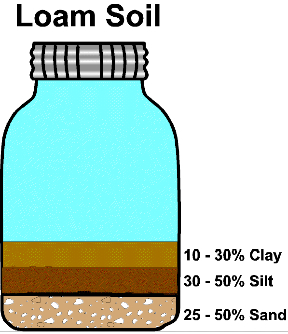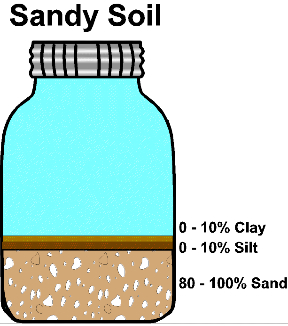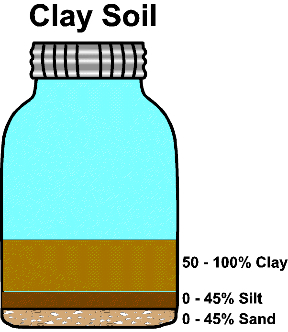soil type
testing

Soil type refers to the texture of your soil. Soil is composed of
mineral particles, organic matter and air spaces.
For earthbags & plaster, you'll want soil that's between about 18%
and 30% clay.
Soil
minerals come in three basic categories: sand, silt and clay. Sand is
the largest
particle. Silt particles are smaller than fine sand but can still be
seen by the human eye. Clay particles are microscopic. The relative
proportion of these particles determines the soil texture.
- Sandy
soil—tends to be very light and dries out swiftly. Water drains very
quickly and makes the soil easy to dig. It's the first to warm up in
the sun.
- Silt soil—retains moisture and feels slippery when wet. Doesn't
dry out as quickly as the sandy soils.
- Clay
soil—very heavy, holds moisture for long periods of time when
wet and dries hard as a brick. Besides being heavy, it tends to be
sticky and very hard to dig. It's the last to
warm up in the sun.
Loam soil—the ideal soil texture - is
composed of all three categories (sand, silt and clay). The ideal loam
soil contains 40% silt,
20% clay and 40% sand (and organic matter, if you're gardening). Loam
is a separate category
because none of its components account for more than 50% of volume.
Test Soil Type by Hand
You'll want to bring along a water bottle, and maybe some jars or
bags for samples. (For the latter, also bring a magic marker & way
to label your samples so you don't get confused.) These are very rough
tests, but allow you to narrow soils down to those that are worth
subjecting to the jar test (below).
TEST
1: Take a handful of soil, and pour some water on it. Feel it and rub
it between your
fingers. If it's rough and gritty and breaks up easily, it's
predominately
sandy. If it feels sticky and like plastic, it's probably mostly
clayey. If it
feels slippery with particles that are smaller than sand, it's
mostly silty. You want something that has elements of all three.
TEST 2: Squeeze the wet soil in your fist, trying to form a lump
with it. If it makes a solid
lump that doesn't crumble, it's got a high clay content. If it crumbles
at once, it's mostly silt
or sand. Rub it back & forth between your hands (like you would
with Play-Doh or, duh, clay). Does it hold up & make an elastic
snake that holds together? Partially?
Test Soil Type by Jar
This test can take several hours to a day or two.
- If you have more than one sample, label or identify your
jars
on
a piece of tape on a mason jar so you can keep things straight. What
part of your land did they come
from? Surface samples, or from depth?
- Place 5
inches(or 5 cm) of soil into the jar and add a tablespoon of powdered
dishwashing detergent. The detergent is a surfactant, which keeps the
soil particles separate, resulting in a more accurate test.
- Fill the jar to the top with water, screw the lid on, and
shake
the jar for three minutes to thoroughly combine the soap, soil, and
water, and to make sure no soil is stuck to the bottom or sides of the
jar.
- Set the jar somewhere stable &
out of the way to let the sediment settle.
- As the sedimentation progresses, check the sample
periodically to
watch the layers form and to note the size of the particles settling
out.
Sand particles are the heaviest of the three and
settle out of the solution after about a minute. The sand layer is
coarser in texture than the silt and clay.
Silt is the next heaviest particle and will settle out after about an
hour. The silt layer is darker than the sand.
Clay,
the lightest particle in the mix, can take from one to two days to
settle out of the solution. The clay layer that settles on top is fine
textured and light in color.
If you like, you can calculate
percentages and transfer the numbers to the soil texture triangle
(below) to determine the composition of your soil. Click image to
enlarge.
1. Measure each layer of sediment
2. Figure out the percentages of
sand,
silt, and clay in the sample.
For example, if you have
5
total inches of
soil in your jar, then every 1/2 inch will be 10%. (1"=20%, 2"=40%,
3.5"=70%,
etc).
Remember:
your ideal soil for earthbags should fall into the "loam" category with
approximately 20% clay, 40% silt and 40% sand.
Amending by Soil Type
If
a soil tends toward an excess in clay, sand or silt,
you can amend it by simply adding & mixing the required components.
Both sand and silt are pretty commonly available in most areas (if
necessary, you can buy them from an aggregate yard for a few dollars
per cubic yard).
Clay
is a little more difficult to find, if it's not common in your region.
You might be able to find sources of clay-rich dirt in river bottoms,
lakes and ponds. Construction sites may have cleared topsoil, leaving
access to clay layers below that you might be able to get permission to
harvest. You can even buy powdered clay from pottery suppliers, but
this can get expensive.
Worst case is that you can use
cement to stabilize clay-poor soil. It works, but cement-stabilized
dirt will be subject to cracking & doesn't offer as good insulative
properties as clay or lime. You can try try mixing a little lime with
your cement. Start with about 8% per volume,
make a few test batches with different percentages of clay, then set
them out in the sun to cure.
A couple of good tests for earthbag-worthy fill are the drop test
(seeing if a dried sample shatters when it hits the ground from chest
height) and
trying to gently drive a nail into your fully-cured sample. If you can,
without it
splintering or breaking apart, you've got gold.
The following is geared more towards
gardening (credit:
http://www.rain.org/global-garden/soil-types-and-testing.htm),
but might help with gaining a comprehensive sense of the three
components & their qualities:
| Type of Soil |
Test Jar |
Sandy
soils come from erosive sources and so are very common near the
mountain foothills, along rivers and
streams and certain coastal areas. Sandy soils are typically comprised
of approximately 80 - 100% sand, 0 - 10% silt and 0 - 10% clay by
volume.
Sandy soils are light and typically very free
draining, usually holding water very poorly due to very low organic
content. |
 |
Loam soils are common
in the valleys and flat areas (flood plains) surrounding rivers and
streams.
Loam soils are typically comprised of approximately 25 - 50% sand, 30 -
50% silt and 10 - 30% clay by volume.
Loam
soils are somewhat heavier than sandy soils, but also tend to be fairly
free draining, again, due to typically low organic content. |
 |
Clay soils are very
common in certain areas, particularly around urban
areas where fill soils have been used to establish grade in
subdivisions and developments. Clay soils are typically
comprised of
approximately 0 - 45% sand, 0 - 45% silt and 50 - 100% clay by
volume.
Clay soils are not typically free draining, and water tends to take a
long time to infiltrate. When wet, such soils tend to allow virtually
all water to run-off. Clay soils tend to be heavy and difficult to work
when dry. |
 |
Edited from
http://www.your-healthy-gardens.com/soil.html
